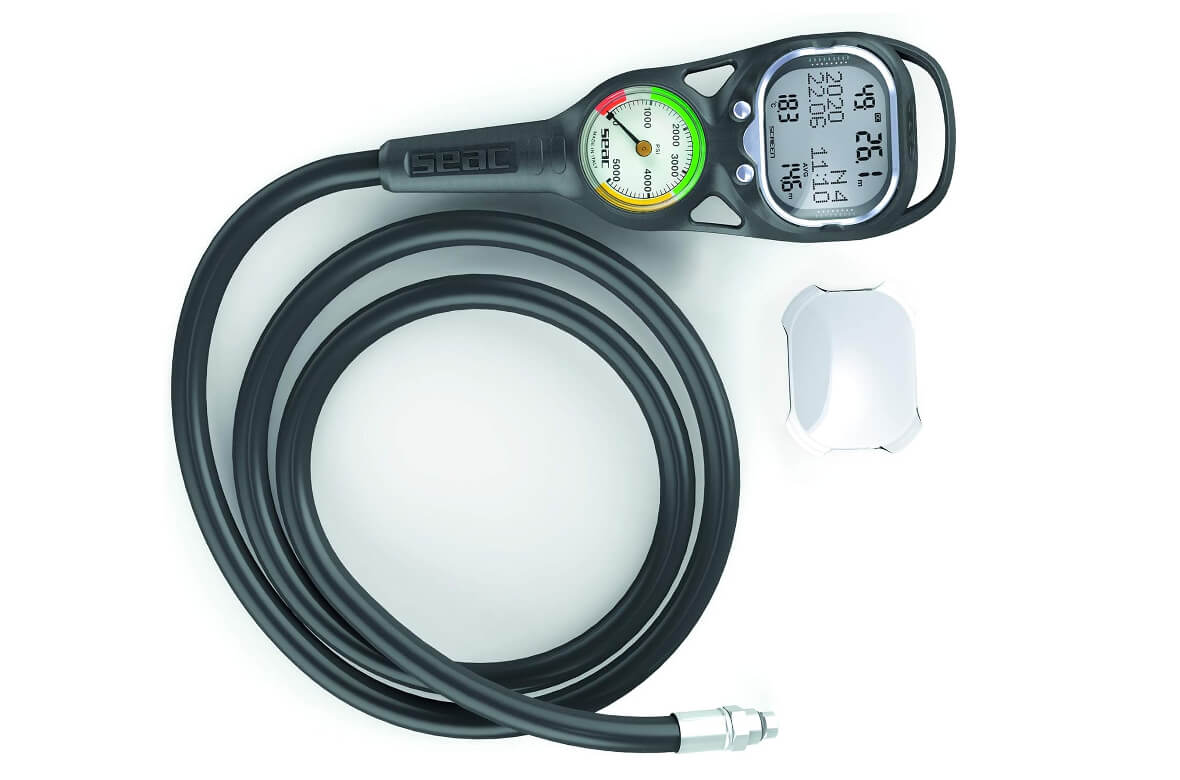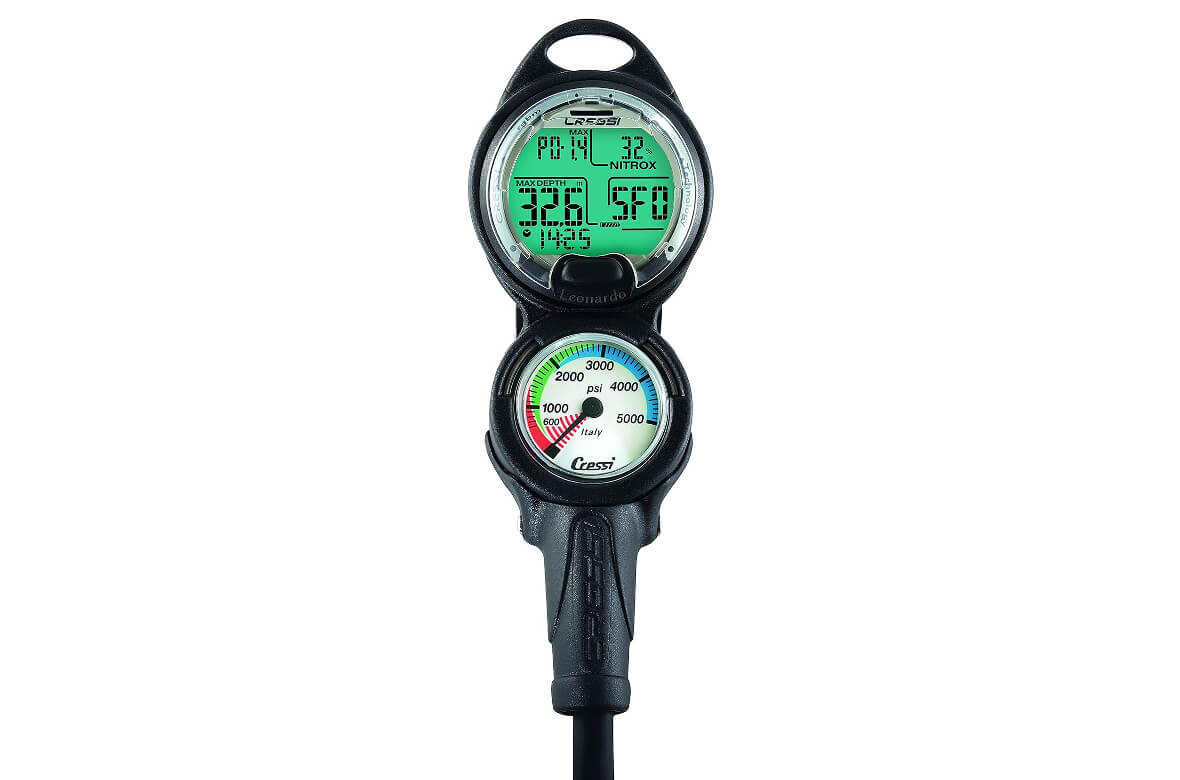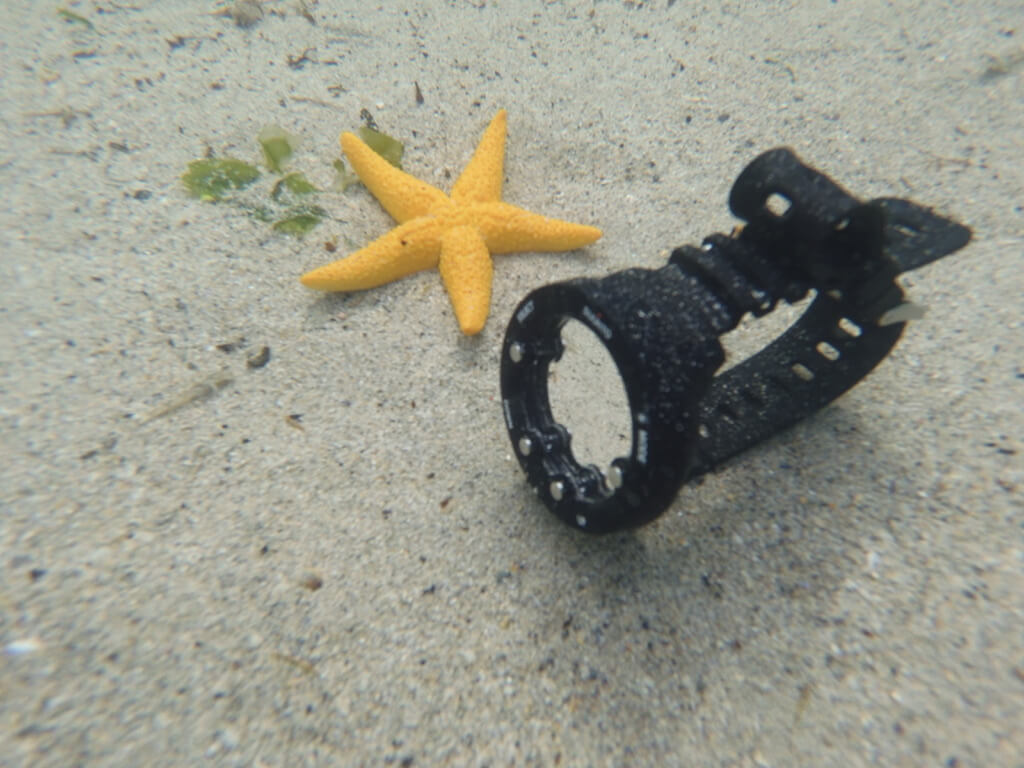Not all console dive computers are equal! Some are relatively cheap but have only the most basic capabilities whereas other models have all manner of cool extra features but cost more.
First of all: just what the hell is a console dive computer anyway!? Well, most dive computers are described as wrist/watch dive computers; because they’re worn on your wrist like a watch.
But console dive computers are different. They’re attached to the SPG hose of the regulator instead.
Console dive computers display all the same info; in the same format as a wrist/watch dive computer; it’s just that to view it you’re looking down at your SPG hose instead of at your wrist. Some folks prefer it that way….
Phew ! Now that’s cleared up, we’ll review the best console dive computers available in 2025.
We’ve started with the cheapest console dive computer currently trending the market and then worked our way up through the other models in order of ascending price. Let’s do this!
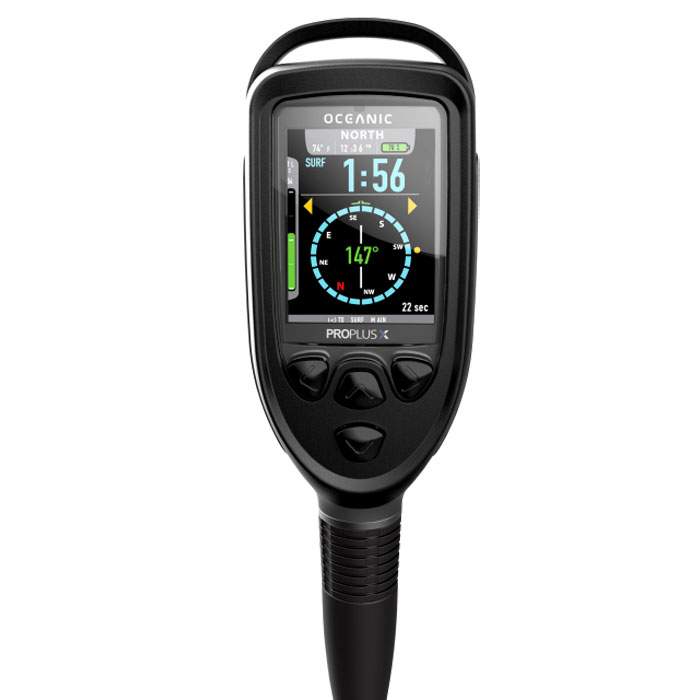
Quick Answer:
- Cheapest: Cressi Console Leonardo 2
- Second Cheapest: Sherwood Scuba Sage
- Beginner’s Choice: Seac Screen Console
- Analogue Compass: Mares Puck Air
- Top Seller: Suunto Cobra3 Black
- Runner-Up Top Choice: Sherwood Wisdom 3
- Top Choice: Oceanic Pro Plus X
REVIEWS:
1) Cheapest Console Dive Computer: Cressi Console Leonardo 2
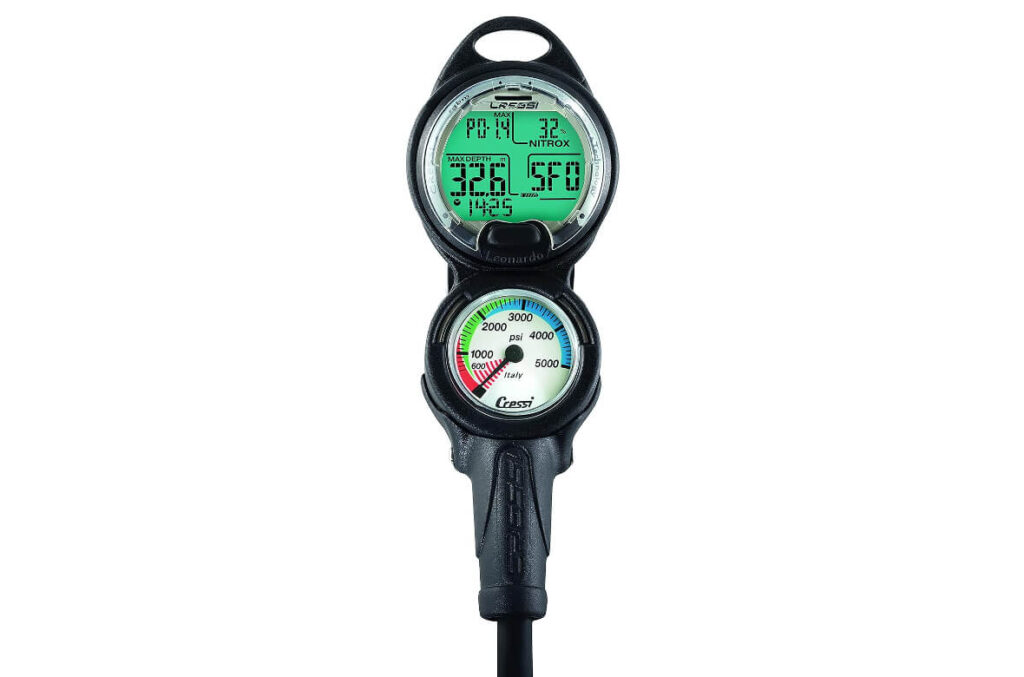
The Cressi Console Leonardo 2 is the cheapest console dive computer out there. Admittedly, it’s a little on the simple side: it lacks a compass and doesn’t give remaining dive time. However, it’s still a decent piece of kit and a great choice for beginners.
Remaining air is shown on the fluorescent pressure gauge; this is is located beneath the dive computer module, which displays current depth, deco time and air mix.
The dive computer module uses a single button interface for simplicity and is outfitted with an audible alarm to warn you if you ascend too quickly as well as a backlight display with time and date. It also has a logbook that can store 75 hours of dive data.
There are a number of dive friendly features such as the ability to set the conservancy level of profiles and a user selectable deep stop function..
Able to operate in air, gauge or nitrox mode, the Cressi Console Leonardo 2 features a chromium plated brass metal case that makes it ultra durable.
PROS:
- Cheapest console dive computer
- Highly visible pressure gauge showing remaining air
- Dive computer module with beginner-friendly 1 button user interface
- Can adjust conservancy of dive profile
- 75 hour dive log and audible ascent alarm
CONS:
- No Compass
- Does not show remaining dive time
- No automatic altitude adjustment
- No tech diving modes
2) Second Cheapest Console Dive Computer: Sherwood Scuba Sage
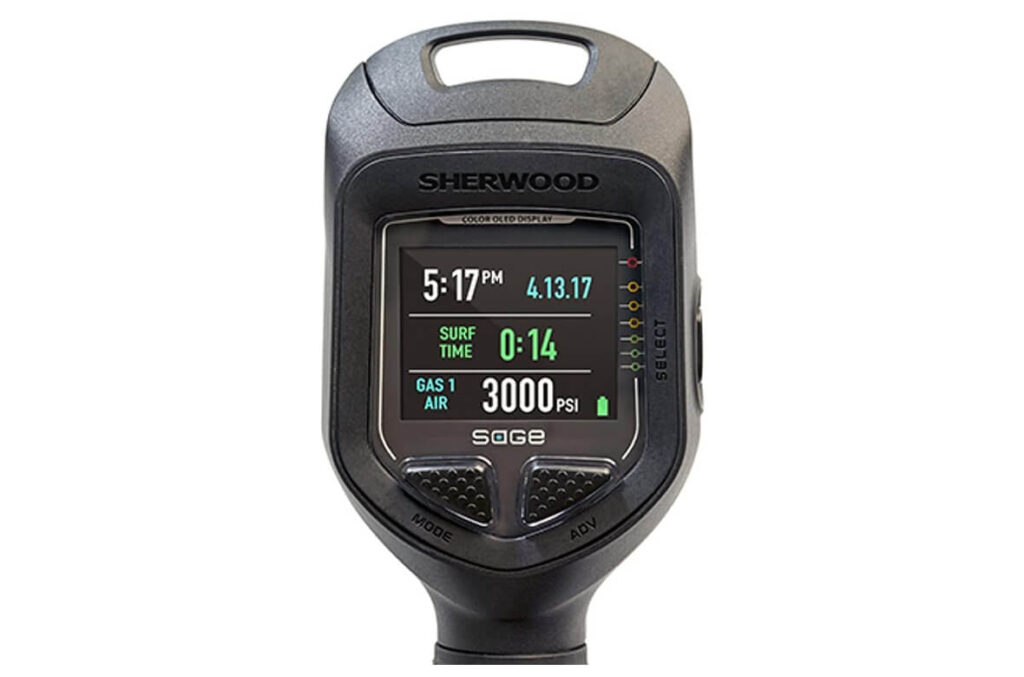
Although it’s the second cheapest option, the Sherwood Scuba Sage is actually one of the very few console dive computers to sport an ultra bright, high definition OLED colour screen, with adjustable intensity, which makes data easy to view even at a glance.
However…whilst data is easy to read when using this dive comp underwater below 40ft, in shallower water and especially on the shore / boat, the screen can be a little dim and difficult to read; which is often a problem with OLED screens.
The Sherwood Scuba Sage also includes a digital 3-axis compass, bluetooth integration and a 40 hour dive log. The user interface is intuitive and easy to understand – it incorporates three buttons that allow for rapid settings navigation.
It operates in air and nitrox modes and uses a patented gas remaining algorithm that provides calculations in real time.
Because all the data is provided on the computer console without any submersible gauge, this is also the most compact console dive computer available.
PROS:
- Second cheapest console dive computer
- High definition OLED colour screen
- Digital compass
- Most compact console dive computer
- Patented gas remaining algorithm
CONS:
- Screen can be difficult to read at surface
- Case is mostly made of plastic so lacking durability
3) Best Console Dive Computer for Beginners: SEAC Screen Console
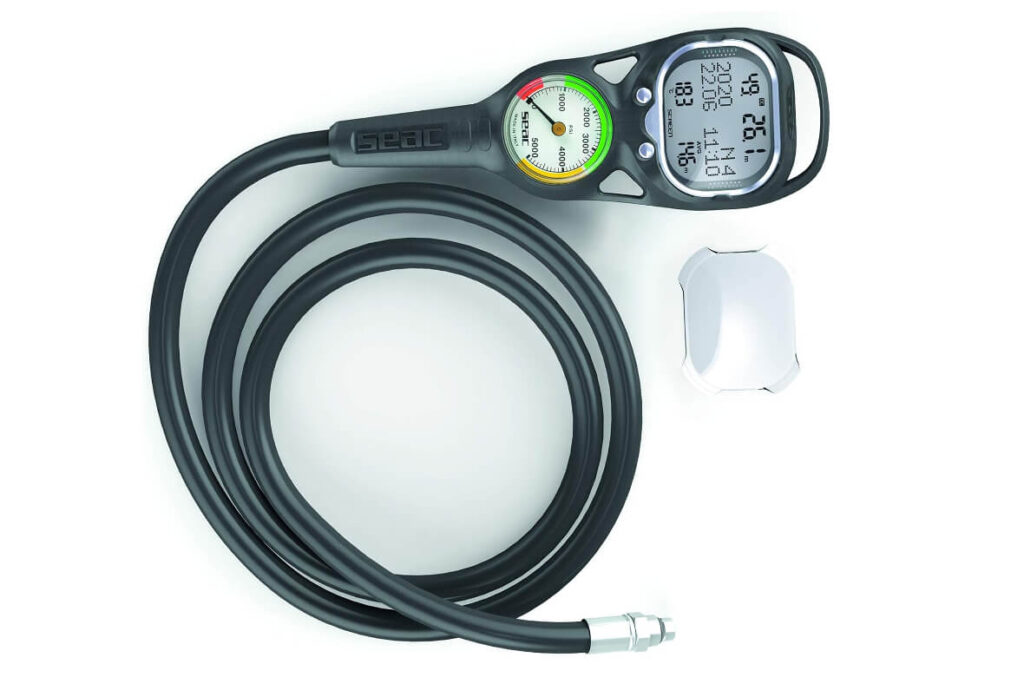
With it’s large screen, simple two-button user interface and low price point, the SEAC screen console is a great choice for beginners.
Remaining air time is given on the fluorescent, colour coded pressure gauge whilst dive data is displayed on the large dot matrix lcd display using bold and distinct characters. You can adjust the brightness and contrast of this screen and there’s also a backlight.
The SEAC Screen Console can operate in scuba, gauge and free dive mode as well as supporting oxygen mixes up to 99%.
It’s also possible to adjust the settings to make the dive profile more conservative plus it includes a 40 hour log book and audible alarms.
PROS:
- Third cheapest console dive computer
- Large and easy to read screen
- Can make dive profile more conservative
- Easy to use two button interface
CONS:
- No compass
4) Includes Analogue Compass: Mares Puck Air
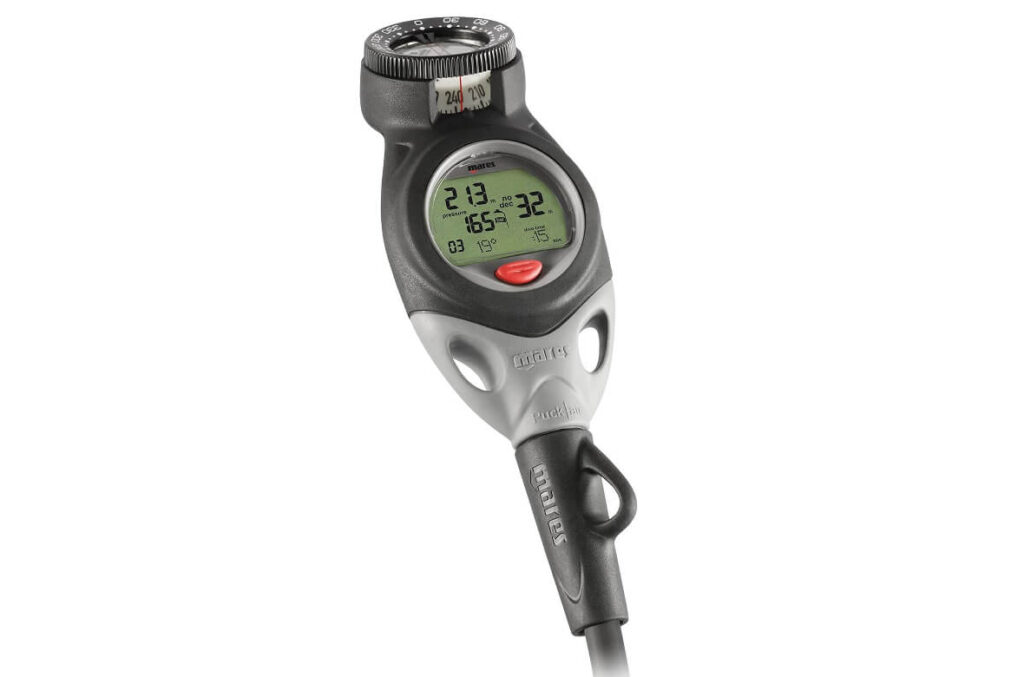
The Mares Puck Air is a mid-price console dive computer but in many ways feels more like an upper end one. It is one of only two console dive computer with a traditional compass – that is to say an old school analogue pointer as a posse to a digital compass.
It’s max depth is 492 ft, which makes it able to go deeper than any other console dive computer out there.
You get the standard features you’d expect with an upper mid-price console dive computer, including an integrated pressure gauge and residual air time calculation, air, nitrox and bottom timer modes as well as altitude adjustment.
On the negative side, you only get 36 hours of dive log memory with this model – which is the smallest memory of all the console dive computers we’ve reviewed.
It’s sturdy design is both compact and durable, whilst the matrix dot display is easy to read and with only one button is also extremely easy to operate.
PROS:
- Analog compass
- Integrated pressure gauge and residual air time calculation
- Easy to read display with dot matrix insert
- 492 max depth – deeper than any other option
CONS:
- Very short dive log – only 36 hours
5) Top Seller: Suunto Cobra3 Black
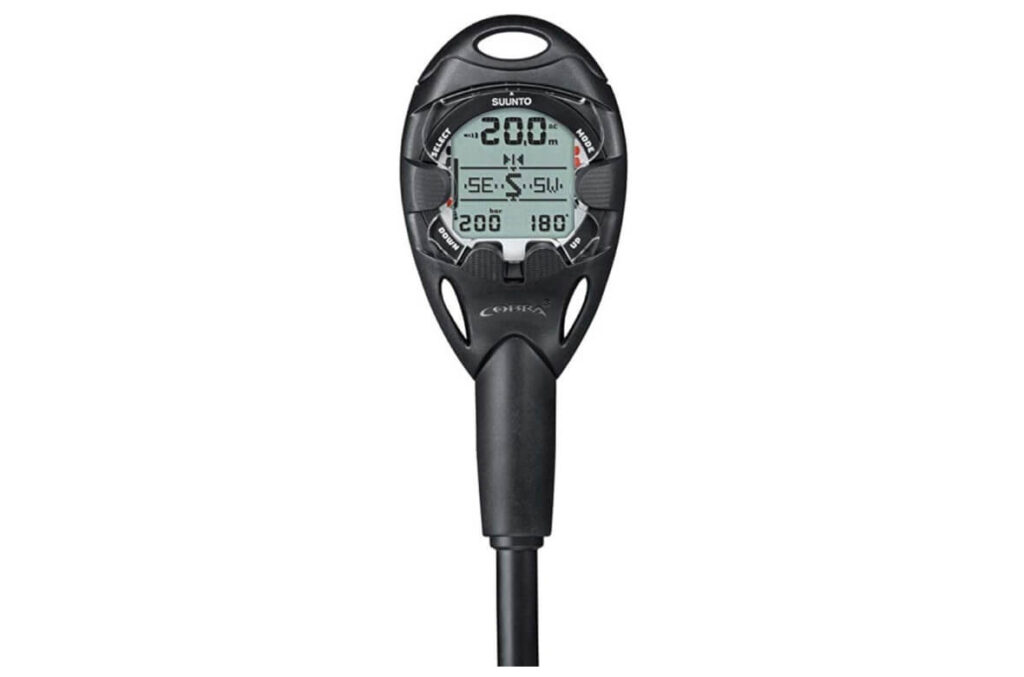
A mid priced console dive computer, the Suunto Cobra 3 Black has a few things cheaper models don’t – for example it includes air integration on it’s computer console, being one of the few console dive comptuers to do so and also the cheapest.
Also, it calculates remaining dive time, has a built in dive simulator and dive planner, operates in air, nitrox and gauge modes and even has an electronic 3D compass which can be titled up to 45 degrees in any direction without impairing readability.
With it’s exceptionally sleek and compact console that has multiple lanyard attachment points and houses an easy to read screen matrix, the Suunto Cobra3 is simple to handle; having a straightforward and intuitive four button user interface.
There’s also a dive log which you can download onto a PC or Mac with the USB interface, although at just 36 hours long it’s shorter than that of most other dive computers.
PROS:
- Air integration on computer console
- Electronic 3D compass
- Shows remaining dive time
- Built in dive simulator and dive planner
- Four button interface for more flexible controls scrolling.
CONS:
- Dive log is only 36 hours long
- Protective case is plastic which can be a little prone to scratching
6) Runner-Up Top Pick: Sherwood Wisdom 3
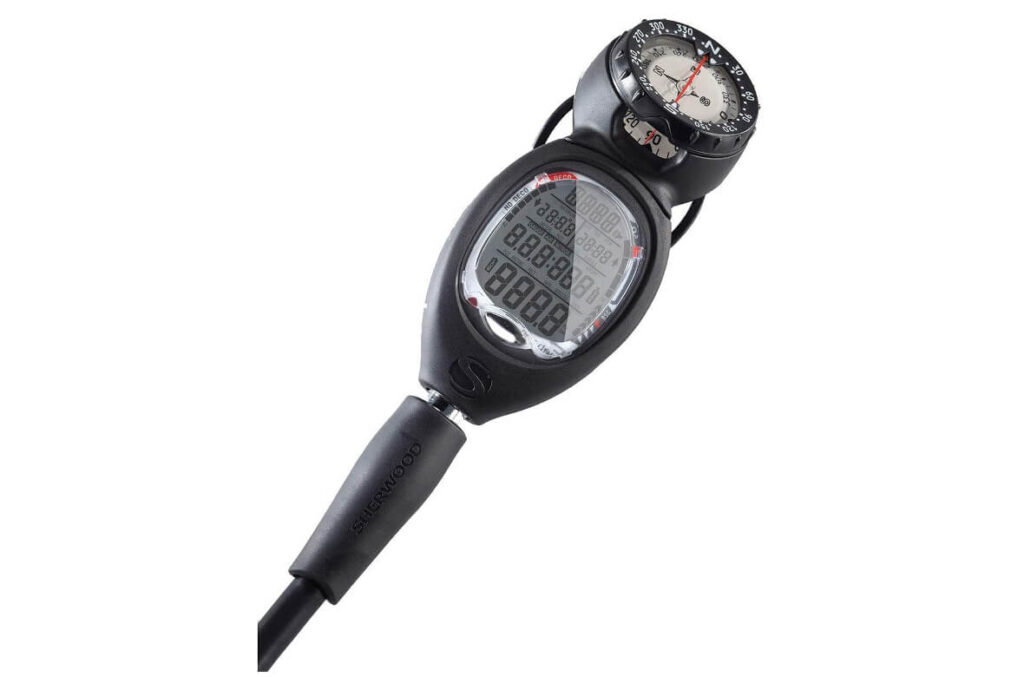
The Sherwood Wisdom 3 is everything that makes a console dive computer great. After the Oceanic Pro Plus X, it’s our next top console dive computer recommendation.
It features an analogue compass, air, nitrox and gauge modes, visual and audible alarms, 70 hour logbook, quick disconnect and is the one of the only console dive computers to feature air integration on it’s computer console.
With an intuitive 2 button operation and a well sized hydro glow screen for illumination, this is a straightforward piece of kit to use and it comes in a sleek design with a stylish matte black finish. There is also an automatic altitude adjustment to 14,000 feet.
Another cool feature of this console dive computer unit is that it is PC downloadable; it comes with a handy dive simulator you can use to walk yourself through any diving scenario to know your limits.
PROS:
- Air integrated computer console
- Analogue compass
- Shows remaining dive time
- Huge logbook
- Air, nitrox and gauge modes
- Expanded Memory for Dive Profiles – access up to 110 dives
CONS:
- Second most expensive console dive computer
7) Top Pick: Oceanic Pro Plus X

In terms of overall quality, and durability: the Oceanic Pro Plus X is the absolute best console dive computer out there and our number one pick. Just a heads up: it’s also the most expensive!
Let’s start with the screen; larger than that of other dive computers, it is an amazingly bright, low energy consumption, thin film transistor display, the brightness of which can be adjusted to sunlight or night diving conditions. It’s extremely to read at any depth.
Data is displayed with an intuitive and unique colour coded interface, which includes bar graph and also the largest, most legible digits of any dive computer out there.
It’s features include repetitive dive planning, remaining dive time display, air integration, nitrox or air mode and an oceanglow backlight.
It also has a 3D digital compass can be accessed on any dive with a single touch of button and with three modes – north, reference and reverse reference.
Depth proof to 330ft and decompressing between 10 and 60 feet, it’s setup allows you to choose the mode of decompression that best suits your diving needs and conditions, thanks to a dual algorithm system.
The Oceanic Proplus X takes advantage of bluetooth 4.0 technology: together with the diverlog app for iOS, you can wirelessly interact with your dive computer and use a smart phone or tablet to control all your dive computer settings plus view log and profile data.
PROS:
- Thin film transistor display with adjustable brightness
- Intuitive user colour code interface with graphs and highly legible figures.
- Digital compass
- Air integrated
- Oceanglow backlight
- Wireless bluetooth connection
CONS:
- Most expensive console dive computer
What the hell is a Console Dive Computer anyway?!
Whereas most kinds of dive computer are mounted on the wrist – like a watch, Console Dive Computers are instead integrated within the Console – y’know the thin, long compartment on the scuba octopus setup, containing the gauge that shows you how much air you have left (and often also contains a depth gauge and sometimes one for a compass to).
Most manufacturers make dive computer models that are only suitable for either a wrist unit or a console. However, some models can fit either.
These days, wrist dive computers are extremely popular and it’s probably safe to say they are the preferred choice among most scuba divers.
However there are several advantages and disadvantages for both wrist dive computers and console dive computers, which mean that some people do opt for console dive computers over wrist dive computers. Let’s take a quick look at the pros and cons of both types of dive computer:
CONSOLE Dive Computer VS WRIST Dive Computer:
PROS:
- Shows all Information at Once – A Console Dive Computer lets you see your depth, dive time, remaining dive time, heading (if it has a compass), remaining gas in your tank and possibly more, all together. A wrist dive computer can show all these things but only if you buy costly extras for it and usually not at the same time as you may have to toggle between functions such as the depth /time info and the digital compass.
- Cheaper – A Console Dive Computer is often cheaper than a Wrist Dive Computer of the same quality / display capacity.
- Sturdier – Being encased in a console, makes this type of dive computer less prone to being damaged or lost.
CONS:
- Not as Easy to See: It is less natural to reach for, find and read a dive console, than it is to simply glance at your wrist as though you were checking the time. In this respect a wrist dive computer is more convenient.
- Smaller Screen: Console Dive Computers are generally smaller than Wrist Dive Computers. In addition to this, they lack the wide screens that wrist dive computers have, meaning it can be harder to see the information displayed on them.
Diving Squad Debriefing:
Ultimately, it really comes down to personal preference! Whilst more scuba divers opt for wrist dive computers these days, for some; a console dive computer will always be the way.
- If you feel that a Console Dive Computer is for you, head back up to our brutally honest Reviews of the Best Console Dive Computers.
- Or, if you think you could be a Wrist Unit Dive Computer kinda diver, check out our Dive Computers Home Page – or these other pages: Best (wrist) Dive Computers for Beginners or Best Cheap (wrist) Dive Computers or even Best Air Integrated Dive Computers. Adventure is out there!
Support the Squad!
We are part of the Amazon Services LLC Associate Program. If you make a purchase on amazon after clicking a link on Diving Squad, we earn a small commission fee, at no extra cost to yourself.
We are also part of several other affiliate programs so if you click on a Diving Squad affiliate link that results in you booking a liveaboard, booking accommodation, purchasing insurance or buying a product somewhere else, once more we make a small commission, without it costing you a cent extra. Thanks!
